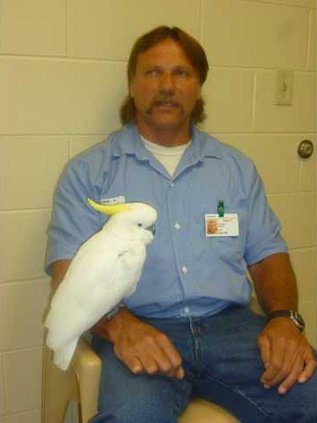By Jim Misunas
jmisunas@gbtribune.com
LARNED — The first time the “Birds Befriended Program,” was offered to the Larned Correctional Mental Health Facility, it was turned down.
Five years later, the Birds Befriended Program is a shining light for LCMHF, which has shown remarkable success stories for inmates, who have changed into role models.
Mike Cargill, director of Public Lands and an expert with over 30 years of experience with large bird species, proposed the development of a prison socialization program for macaw parrots which have been surrendered to the Brit Spaugh zoo. With an average lifespan of more than 70 years, some pets had outlived their owners or were abandoned. The zoo did not have the time or the staff to devote to working with the birds.
“When Mike told us about the parrots, they had so many birds, they did not know what they were going to do,” said Ray Reno, LCMHF deputy warden. “We talked about a bird program. They were planning a Raptor Center and thought they would receive birds which needed to be rehabilitated.”
Reno always thought the program appeared to be a good fit with inmates at LCMHF, which is designated for persons with persistent mental illness. Many are long-term inmates at the maximum custody facility.
Socialization of birds differs from training of dogs or horses, in that the human-animal relationship is built on trust, not dominance. The birds need time to become familiar with surroundings and to build a trusting relationship with people.
“They are all about trust and it takes time to build that trust,” Reno said. “Time is something that many of the inmates have.”
Reno said the inmates must pass several barriers before they qualify for the bird program. They must have stabilized medications and pass scrutiny of unit counselors, mental health staff and medical staff. They also must be recommended by a staff committee.
“The success of the program has always relied on the inmates,” said Perez, “It’s an innovative program that has shown success. This is a program has goes beyond the normal educational classroom setting.”
Perez said a point of success was marked when one inmate who had trained a bird for many years was concerned how he would fare after he was released without the bird.
“It was determined that the inmate and the bird were released at the same time,” said Greg Perez, Greg Perez, LCMHF correctional officer II. “Both inmate and bird are doing well.”
Cindy Stejskal wrote in a prior article that LCMHF Warden Karen Rohling and prison staff felt some of LCMHF’s long-term maximum-security offenders were perfectly suited. They believed the therapeutic value of this daily interaction, combined with the responsibility of caring for another living creature, would be of substantial benefit to the offenders.
Secretary of Corrections Roger Werholtz and Deputy Secretary Charles Simmons gave their approval to proceed.
Stejskal wrote that Cargill introduced LCMHF to the Macaw parrots to the inmates who were interested in becoming caretakers. The program started with two blue and gold Macaws. They are highly sociable personalities and ability to adapt to new surroundings.
Birds Befriended program enjoys colorful history
Program started in 2006




